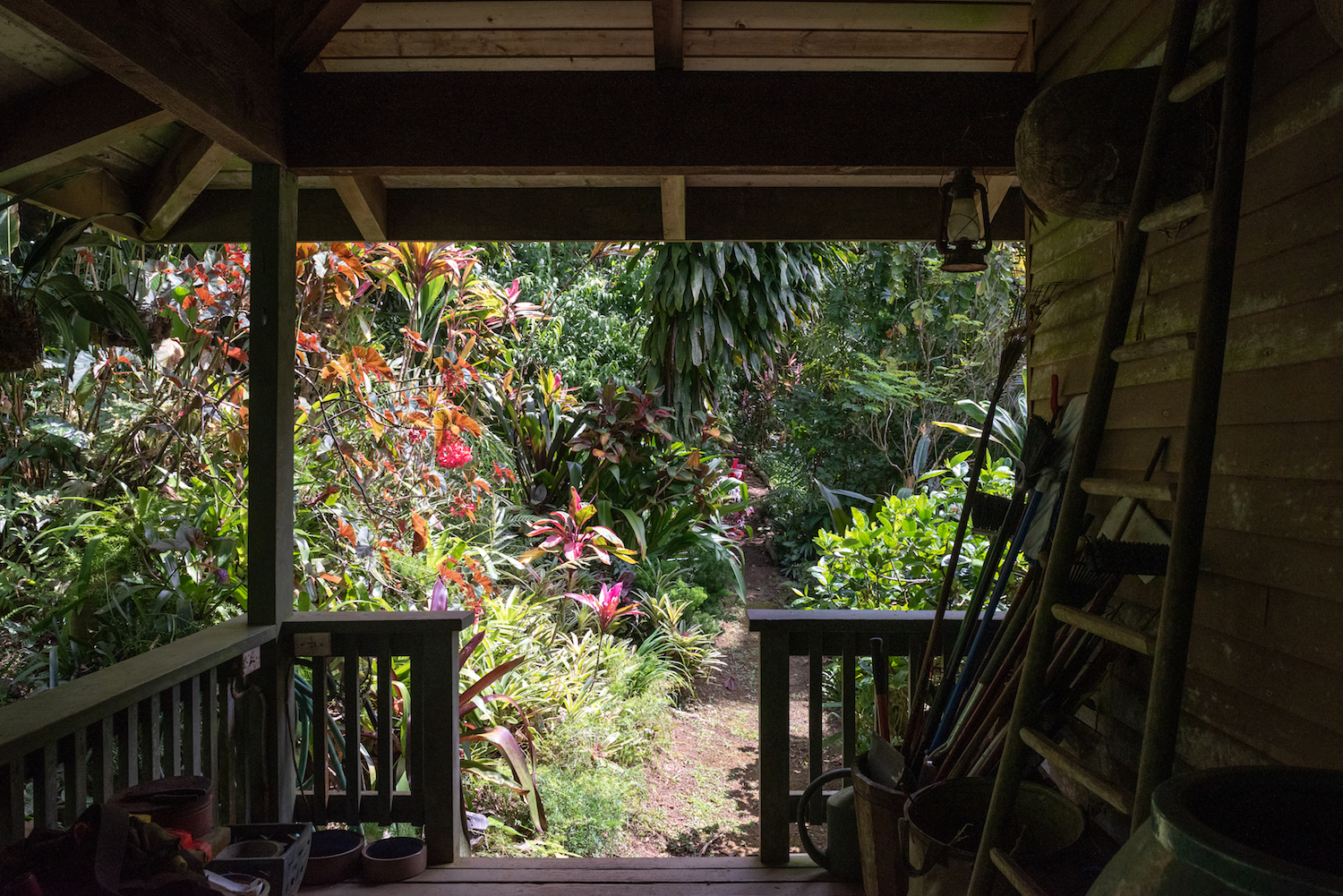Images by Chris Rohrer
The tops and trunks of monumental palm trees block the view of the Pacific from the lānai of the Merwins’ Maui house. Paula Merwin explained why the same way to anyone who asked: “William thinks, if you want to see the ocean, go and see the ocean!” It’s a common wish to live within sight of the roiling blue-blue sea, but from the day he arrived in Hawai‘i, poet W.S. Merwin was preoccupied with the fecundity of the land beneath his feet and the possibility it held for growing plants and poetry. Climb the hill behind the house, or down the single-track road to a small bay, and you find the Pacific. But you must make the effort, according to William, with that as your intention.

It took me several years of visiting William and his wife, Paula, to really explore their land. There’s a simple explanation: I’d arrive for lunch at 12:30 p.m., and before long, it was dark out and we’d be thinking about dinner or the flight back to O‘ahu I was missing. A dam of conversation always burst the moment William emerged from his writing and we sat down to eat. One day we might disappear into Hawai‘i’s complex history, which fascinated and disturbed us both, and where William found a rich vein to mine for his page-turning epic poem “The Folding Cliffs.” Another day, our extended family might take center stage; his mother and my grandmother were first cousins and were close growing up. At some point though, the talk always moved to books and writing. This was when you realized you were seated at the table of a living master.
You have to walk through a corner of the Merwins’ enchanted forest to get to the house, along uneven stone-cobbled paths through a tunnel of shimmering and translucent greens. At first, I simply thought of it as one of the finest gardens I’d seen. The piles of trug baskets and trowels by the front door pointed to the Merwins as gardeners, not forest builders, as did the lilies and hibiscus flowers popping with scarlet and pink and the moss-encrusted stone fountain burbling nearby. But as my visits grew longer, sometimes overnight, I started to wander. I began then to understand the depths and layers of the place, like William’s poems, and its importance to Hawai‘i, but also to humankind.

Books and banana bread at Merwin’s home. 
The writer Robert Becker.
During the day, the forest steals your eyes and keeps them busy: the swaying of grand palm crowns in the canopy, the flitting of a single leaf, the mulchy browns and ochres of fungi seeping from decomposing logs lining the paths. Nighttime was something different. Lying on the knobbly futon mattress in the library, eyes closed, I heard the forest speak. The sound of palms chattering and screeching is nothing like the mournful howling of other tree forests. It is more lively, like a party. And if, for a moment, you drift away, a frond crashing 100 feet to the ground outside the window reminds you where you are. At night, I might forget a man planted this forest—that it hadn’t actually been there forever—that before his tenure, the area had been essentially barren. It was William who had set in motion this forest’s elegant conversation.

The property, now the Merwin Conservancy, is the site of a revolution. The exposed spit on the north shore was deforested centuries ago, and decades of trade winds whipping over the denuded highland carried away its topsoil. A sugar plantation operated there until the 1960s, after which the dirt could support little other than invasive shrubs and weed-grasses, so the peninsula was turned over to ranging cattle. After he bought his first few acres in the early 1970s, William tried to restore the native flora without success. But mountains of horse manure and the fertile effluence of mango and certain ironwood species he subsequently planted worked their alchemy in time, slowly bringing the earth back to health enough to support fledgling palms. Fifty years later, there’s this forest where there once was a fallow field. The story of the place, really, is one of possibility, of what a single person can do in this moment of desperate need.

The exterior of where Merwin would meditate near his home. 
Inside one of the poet’s libraries.
When the Merwins began talking about making the house and land into a conservancy, I was eager to help. The idea was abstract then, something far in the future, and the two of them not being present was only spoken of, not imagined. I joined the board of directors of the Merwin Conservancy a few years later, when William asked me to take his seat so he could focus on a few last books of poems. Now the future is here, on the heels of the death of William, my dear friend, cousin, and mentor, in March 2019. I’m in New York City as I write this, just a block away from Cooper Union, where he taught in the 1980s. A consolation is knowing that we’ll always have W.S. Merwin’s poetry, and that his forest will continue to speak to me and everyone else.
Robert Becker lives in Honolulu and New York City. He was the arts editor and a writer for Andy Warhol’s Interview Magazine in the 1980s, is the author of a biography of Nancy Lancaster (Knopf), and has written about the arts, travel, and history for many publications. He can be found on Instagram at @robertbecker3.
Learn more about the Merwin Conservancy at merwinconservancy.org.





